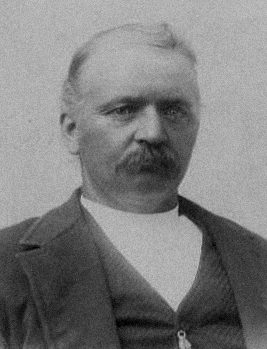Contributed By: LeeTRomrell · 22 February 2013 ·
JAREN TOLMAN, Son of Judson and Sarah Lucretia Holbrook Tolman
April 18, 1853 – September 15, 1912
Jaren Tolman was born in Tooele, Tooele, Utah, April 18,1853. He was the fifth child and third son of a family of fourteen children born to Judson and Sarah Lucretia Holbrook Tolman. Judson had arrived in the Salt Lake Valley, September 20 1848 as a member of the Brigham Young Company. In 1849, Judson was called by Brigham Young to settle Tooele, Utah. It was a real struggle in settling Tooele because of the many battles with the Indians. Finally, when the Indians had stolen his last yoke of oxen and cow, Judson tracked the Indians down and got his stock back. By this time, Judson was tired of fighting with the Indians and packed up his family and moved to the east bench in Bountiful, Utah in 1854.
Jaren lived here the remainder of his life. He went through all the trials of pioneer life. When he was sixteen years old his mother died leaving a large family. It was a real problem and worry to feed a large
family. His mother used to make bread from bran and there wasn’t always enough of that. He once told of a time when he went up to a saw mill owned by a man named Henry, and there was a large pile of
sawdust. He filled his hat and ran home to his mother in excitement, telling her that they could have all the bread they wanted as there was plenty of bran at the saw mill. His mother began to cry at his
disappointment. The mill was located on eighth east and fourth north, across the street from the Sarah Tuttle home.
During his lifetime, Judson built and operated four or five saw mills in and around Bountiful. One saw mill was located up Holbrook Canyon. It was named after Joseph Holbrook, who was Judson’s father-in-law, with whom he also owned a saw mill on Millcreek. Later in life, as Jaren began working with his father in the lumber business, they built one of these saw mills on Stone Creek just above 1300 East and about 300 North. The mill was located just east of where 1300 East crosses Stone Creek. This area will be remembered by residents of Bountiful for some time to come….because during the floods of 1983 a massive wall of water hit this area which gave way and continued down the hill and into the homes below. This writer will not forget evacuating his family at 11:00 p.m. in the night as the mud and water ravished our homes and changed our lives forever.
In 1857 the Saints started building the Tabernacle on Main Street. During the winter Jaren’s father, Judson, and others began to harvest timber above Bountiful to help start construction. When Jaren was
about 10 years old the Tabernacle was just being finished and Jaren was probably involved in small tasks to help his father complete this beautiful chapel. This experience gave Jaren insight into the lumber and
construction business and was the influence he needed to go into that business.
Later in life, Jaren did quite a bit of construction around the Bountiful area. When it was decided in the early 1900’s to build a school, Jaren was put in charge of construction of the Stoker School (which still
stands just south of the Tabernacle on 200 South and 100 East, and currently is used by the University of Utah for adult classes in the Bountiful area). Stoker School was completed in 1904 when Jaren was 51
years old. Jaren was a self-made man, a great reader and calculator. He was one of the early school teachers of Bountiful.
Few men knew the history of the Bible as well as he did. He was a very interesting conversationalist a splendid teacher and a school board member. He was also active in civic affairs.
Prior to the building of Stoker School, Jaren kept busy farming, teaching school and delivering ice, besides his construction endeavors. Around the early 1880’s when Jaren was in his 30’s, he and his
father would divert water from their saw mill on Stone Creek into a pond below 1300 East and west of what is now known as “Rocket Park,” (about 100 North 1100 East). During the winter months this pond
was used to get ice for businesses and families. Jaren Tolman was one of the first in Davis County to put up ice as a business. The pond water would freeze to about 12 or 14 inches thick. Jaren would cut it by
plowing it one way with a horsedrawn plow into 4-foot strips and then sawing it by hand the other way to two feet. Then the 2′ X 4′ blocks of ice would be taken into the ice house and covered with sawdust
from the saw mill for insulation and to keep it from melting. They supplied the stores and butcher shops of Bountiful, as well as residents wishing to buy it.
Eric Tolman remembers skating on the pond in the winter with his brothers, sisters and friends, and playing in the ice house during the summer months. His sister Lucille Tolman Knighton recalls that quite
often this technique would let the ice keep until mid-July. This would enable many to make ice cream for the 24th of July celebration. Jaren would also haul ice to Salt Lake City, where he could sell it for $2.00 a
ton. At today’s standards, it seems like a lot of hard work for a small amount of money.
Jaren’s first home was directly east of the park across 1300 East (which was known as Tolman Road until the early 1900’s when street addresses began) at 180 North 1300 East. It still stands today and is owned
by John B. & Ruth Brydson.
He was always good and kind to the poor and willing to help a stranger, although he was not a man of surplus means. His pleasant personality made him a leader with the young people and he enjoyed
working and taking part in the dancing and dramas of this early time. Being well read in the gospel, he was a fine teacher. He was always a good, kind father and taught his children to live their religion but
they were like all others and had their faults. He always paid an honest tithing and was a man of great faith. When sickness was in the home his first thought was to call upon the Lord and the doctor was only
called of real necessity.
Jaren’s daughter, Emma Tolman Riley, told the following experience: “I will relate a faith promoting incident which I shall always remember and often think of it when I think of my father. He had been
suffering with rheumatism, being confined to his bed, he was perfectly helpless not even being able to feed himself. He asked his wives and children to fast one Sunday morning and then go to Sunday School,
with the exception of someone to care for him. When we returned home he had us all kneel around his bed and each one according to our age, pray for him. When the last one had finished he got up and
walked. In the afternoon William Holbrook and his wife came to see him and they were surprised to see him around because they thought he was so ill. Father told them of how the Lord had heard our prayers.
All of us that were old enough can remember this incident, and it has always been a testimony to me.” Father was a firm believer in the word of wisdom and always tried to live it. If he did break this principle
it was through hard work. The days never seemed long enough and he was a firm believer in teaching his children to work.
Father had blue eyes, light complexioned and was a large man, not so tall but heavy-set and he weighed over 200 pounds. Our pioneer heritage has really given us something to be proud of. It is amazing how
much these ancestors sacrificed and worked. Tolman history tells us that throughout the years the Tolmans owned and farmed the area from south of Stone Creek to about 4th South, and from 13th East
to the base of the mountains.
The area for the Bountiful Temple came into Jaren’s hands when he purchased 18 acres, of the north part of the 40 acres, from John H. Barlow, Sr. on 2 Jan 1898. Jaren and his family farmed this area for 14
years, mostly raising hay. This was all done by means of dry farming, because irrigation was not available. It is exciting to know that a House of the Lord was literally established in the “tops of the
mountains” and on land that once was toiled and turned by our ancestors. On May 13, 1912 the land was deeded to Sarah Jane Burningham Tolman, Jaren’s third wife. She held it until June 3, 1914 when it
was sold to her son-in-law, Elmer Parkin on June 4, 1914.
He had four wives. They were as follows: Emma Briggs, to this union seven children were born, one boy and six girls: Jaren Thomas, Emma Elizabeth, Ann Lucretia, Hattie Naomi, Martha LaVerna, Nancy Alice and Bertha May.
Mary Ann Briggs, a sister to Emma, was his second wife. She and Jaren had one girl and five boys: Judson Lamoni, Ephraim, David Rex, Ann Lucinda, Mahonri Moriancumer, and Elmer Jaren.
His third wife was Sarah Jane Burningham. Sarah Jane bore him four girls and four boys: James Burningham, Sarah Constancia, Lydia Vilate, infant son, Ezra Burningham, Elvinia Jane, Ora Eugene,
Theadocia and another infant son.
Mary Bybee Patterson, his fourth wife, gave him one girl and two boys: Jaren Bybee, Minnie Marie, and Hewett Bybee.
Jaren had a total of 24 children with well over 3,000 descendants by the year 2000. Jaren was admired by the community in which he lived and was loved by his family. He died September 15, 1912 at Bountiful and was buried in the Bountiful Cemetery. (Written by his daughter, Emma Tolman Riley and Thomas B. Tolman, second great grandson and edited by Loraine Tolman Pace, great granddaughter of Jaren Tolman.)
Visit FamilySearch to learn more about Jaren Tolman. Visit the Thomas Tolman Family Organization to find out how you can get more involved in family history.


